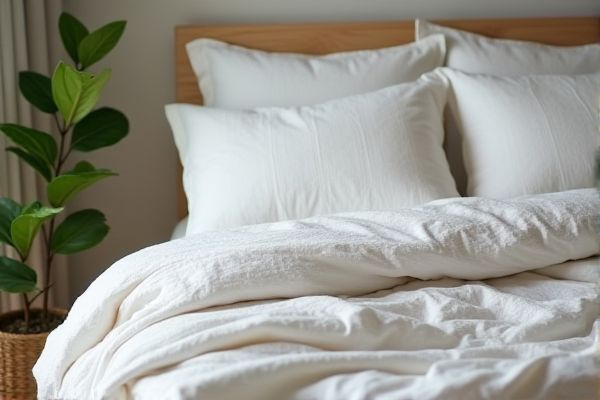
Organic cotton bedding offers a natural, breathable, and hypoallergenic option that is gentle on sensitive skin, while microfiber bedding provides a budget-friendly, wrinkle-resistant, and durable alternative with moisture-wicking properties. Discover which bedding type best suits Your comfort and lifestyle needs by reading the rest of this article.
Table of Comparison
| Feature | Organic Cotton Bedding | Microfiber Bedding |
|---|---|---|
| Material | Natural cotton fibers, grown without synthetic pesticides | Synthetic polyester fibers, man-made from petrochemicals |
| Breathability | Highly breathable, absorbs moisture | Less breathable, traps heat |
| Softness | Soft, gets softer with washes | Very soft, smooth texture |
| Durability | Strong and long-lasting with proper care | Durable but prone to pilling over time |
| Hypoallergenic | Natural, ideal for sensitive skin | May cause allergies due to synthetic fibers |
| Environmental Impact | Eco-friendly, biodegradable, sustainable farming | Non-biodegradable, petroleum-based, higher carbon footprint |
| Care Instructions | Machine washable, avoid harsh chemicals | Machine washable, quick drying |
| Cost | Higher price, premium quality | More affordable, budget-friendly |
Introduction to Organic Cotton and Microfiber Bedding
Organic cotton bedding is made from fibers grown without synthetic pesticides or fertilizers, offering breathability, hypoallergenic properties, and eco-friendly benefits. Microfiber bedding consists of finely woven synthetic fibers, typically polyester, known for durability, softness, and moisture-wicking capabilities. Consumers often choose organic cotton for its natural, sustainable qualities, while microfiber appeals for affordability and easy maintenance.
Material Composition: Organic Cotton vs Microfiber
Organic cotton bedding is made from natural cotton fibers cultivated without synthetic pesticides or fertilizers, ensuring a breathable, hypoallergenic, and biodegradable fabric. Microfiber bedding consists of finely woven synthetic fibers, typically polyester, known for durability, moisture-wicking properties, and resistance to wrinkles and stains. While organic cotton offers eco-friendly and natural comfort benefits, microfiber provides enhanced performance features and affordability.
Environmental Impact and Sustainability
Organic cotton bedding is cultivated without synthetic pesticides or fertilizers, significantly reducing soil and water pollution while promoting biodiversity. Microfiber bedding, made from petroleum-based polyester or nylon, contributes to microplastic pollution and relies on non-renewable fossil fuels, increasing its environmental footprint. Choosing organic cotton supports sustainable agriculture practices and biodegradability, making it a more eco-friendly option compared to the synthetic production and disposal issues of microfiber bedding.
Comfort and Breathability Comparison
Organic cotton bedding offers superior breathability and moisture-wicking properties, creating a cooler and more comfortable sleeping environment compared to microfiber bedding. The natural fibers of organic cotton allow for better air circulation, reducing heat retention and minimizing night sweats. In contrast, microfiber bedding, made from synthetic materials, tends to trap heat and moisture, which can lead to discomfort, especially for those who prefer a cooler sleep surface.
Allergies and Skin Sensitivity: Which is Safer?
Organic cotton bedding is naturally hypoallergenic and breathable, reducing the risk of irritation for sensitive skin and allergy sufferers. Microfiber bedding, while soft, often contains synthetic fibers that can trap allergens and may cause discomfort or exacerbate skin sensitivities. Choosing organic cotton bedding can provide your skin with safer, chemical-free comfort and minimize allergic reactions.
Durability and Longevity of Each Bedding Type
Organic cotton bedding boasts natural fibers that typically offer excellent durability and become softer with each wash, ensuring long-lasting comfort. Microfiber bedding, made from tightly woven synthetic fibers, resists wear and tear effectively but may pill or lose texture over time. Choosing organic cotton bedding ensures your investment in quality and longevity aligns with sustainable and breathable material benefits.
Care and Maintenance Requirements
Organic cotton bedding requires gentle washing in cold water with mild detergents to preserve its natural fibers and avoid shrinkage, while microfiber bedding offers easy-care advantages due to its resistance to wrinkles, stains, and quick-drying properties. Organic cotton is more prone to wear if exposed to harsh chemicals or high heat drying, necessitating air drying or low heat settings to maintain fabric integrity. Microfiber bedding maintains softness and durability with less frequent washing and can withstand machine drying on medium heat without significant damage.
Cost Differences: Affordable vs Premium Choices
Organic cotton bedding typically carries a premium price due to sustainable farming practices and higher production costs, reflecting its eco-friendly and hypoallergenic qualities. In contrast, microfiber bedding offers a more affordable option, made from synthetic fibers that allow for mass production and lower manufacturing expenses. Consumers weighing cost differences often choose microfiber for budget-friendly durability, while organic cotton appeals to those prioritizing natural materials and environmental impact.
Aesthetic Appeal: Texture and Design Variety
Organic cotton bedding offers a natural, soft texture that enhances bedroom aesthetics with breathable, matte finishes and subtle, earthy tones. Microfiber bedding provides a smooth, silky feel with a broader variety of vibrant colors and intricate patterns due to its synthetic fibers. Your choice depends on whether you prioritize the natural elegance and texture of organic cotton or the vivid design versatility of microfiber.
Making the Right Choice for Your Bedroom
Organic cotton bedding offers superior breathability and natural hypoallergenic properties, making it ideal for sensitive skin and a comfortable night's sleep. Microfiber bedding provides a budget-friendly option with high durability and moisture-wicking capabilities but may trap heat more than organic cotton. Your choice depends on prioritizing natural materials and sustainability versus affordability and easy maintenance for your bedroom.
 homyna.com
homyna.com